Mercury
Mercury is a naturally-occurring chemical element found in rock in the earth's crust, including in deposits of coal. On the periodic table, it has the symbol "Hg" and its atomic number is 80. It exists in several forms: Elemental (metallic) mercury.
Mercury as a metal is used for extraction of gold and silver, as a catalyst for chlor-alkali production, in manometers for measuring and controlling pressure, in thermometers, in electrical and electronic switches, in fluorescent lamps, and in dental amalgam fillings.

